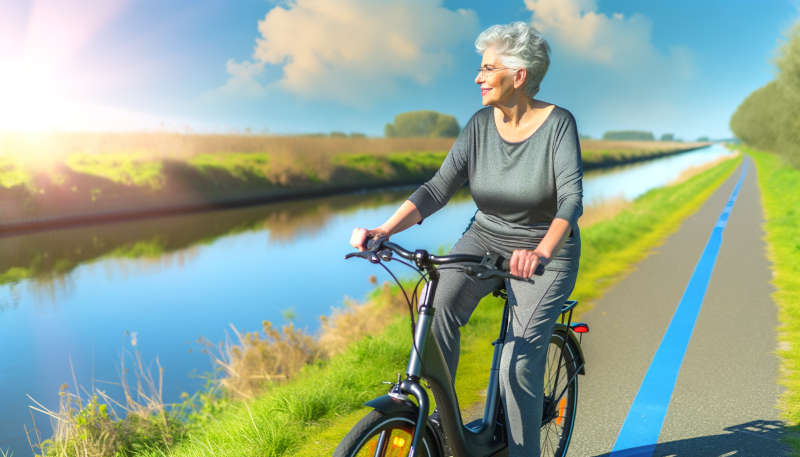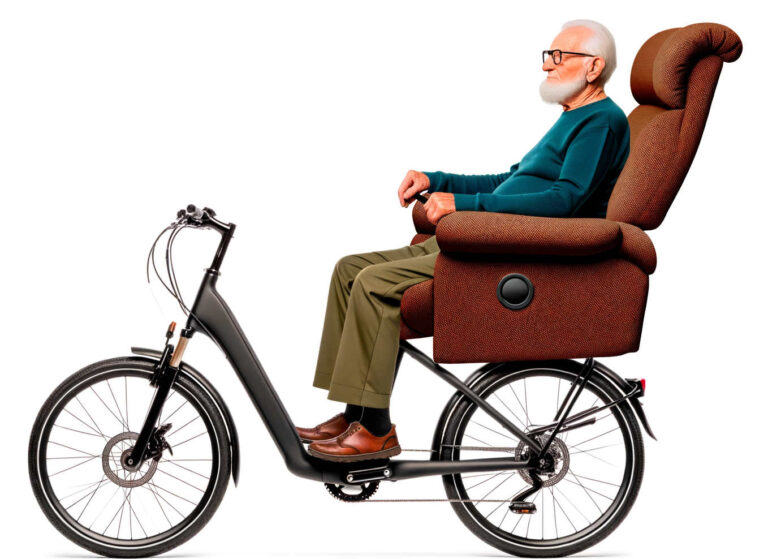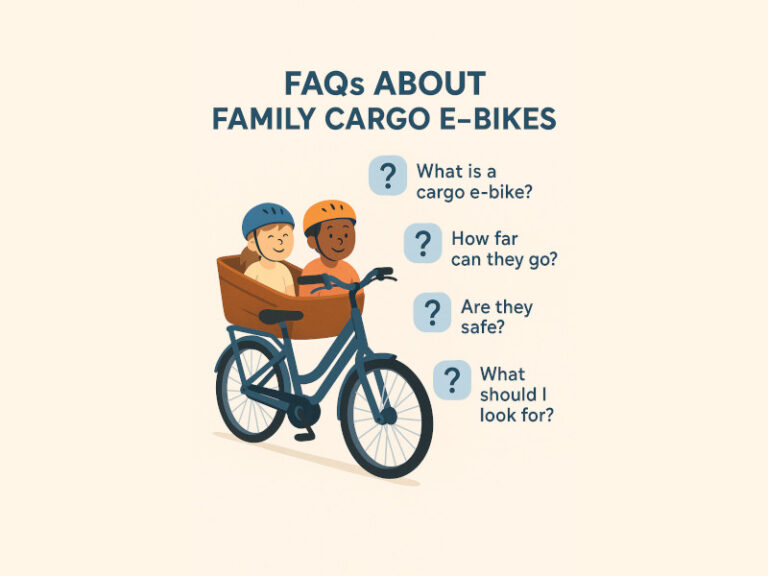Are E-bikes Good for Seniors? The Answer May Surprise You!

Is 70, 80, or 90 Too Old to Ride an E-bike?
Age alone does not determine whether someone is too old to ride an e-bike; instead, it depends on individual health, fitness levels, and cycling experience. Many people in their 70s, 80s, and even 90s continue to enjoy riding e-bikes. E-bikes, with their pedal-assist features, can make cycling accessible and enjoyable for older adults, providing a means to maintain physical activity, independence, and social engagement. However, safety should be a top priority, so potential riders should consult with their healthcare provider to ensure they are physically capable of riding.
Factors such as balance, coordination, cardiovascular health, and any pre-existing medical conditions need to be considered. Older adults should choose an e-bike suited to their needs, with features like a comfortable seat, easy step-through frame, and appropriate power levels. It’s also essential to wear protective gear, including a helmet, and to start with short, manageable rides to build confidence and endurance. With proper precautions, many seniors find that e-bikes offer a wonderful way to stay active and enjoy the outdoors.
E-bikes for Seniors and the Elderly
Electric bikes (e-bikes) and pedal-assist bikes offer an excellent way for seniors and the elderly to stay active, improve their physical health, and enjoy the outdoors. These bikes come with electric motors that provide varying levels of assistance, making cycling more accessible for those who might struggle with traditional bicycles due to age-related issues like reduced stamina or joint problems. E-bikes and pedal-assist bikes help to reduce the physical strain, allowing older adults to enjoy longer rides without excessive fatigue. This can lead to improved cardiovascular health, better mental well-being, and increased social interaction.
Pedal-assist bikes, often referred to as pedelecs, provide assistance only when the rider is pedaling. The electric motor “kicks in” to amplify the rider’s effort, making it easier to climb hills, ride against the wind, or cover longer distances. This type of bike encourages physical activity, as the rider must still pedal to receive assistance. Pedal-assist bikes typically have multiple levels of assistance, allowing riders to choose the amount of help they need depending on their physical condition and the terrain. These bikes are particularly beneficial for seniors who want to maintain an active lifestyle but need some help to make cycling more manageable.
In contrast, e-bikes with a throttle mode can be operated without pedaling at all. The rider can engage the throttle to propel the bike forward using the electric motor alone. This option can be especially useful for seniors who may have significant mobility issues or for those who need a break from pedaling during their ride. However, throttle-only mode e-bikes might not provide the same level of cardiovascular benefits as pedal-assist bikes, since they don’t require physical exertion. It’s important for seniors to consider their individual needs and fitness goals when choosing between a pedal-assist bike and a throttle-only e-bike. With proper selection and usage, both types of e-bikes can greatly enhance the quality of life for seniors and the elderly by promoting physical activity and enabling greater independence.
Benefits of an E-bike vs Regular Bicycle for Seniors
For seniors, the shift from a traditional bicycle to an electric bike (e-bike) can significantly enhance mobility and independence. Unlike regular bicycles, e-bikes come with a battery-powered “assist” that can be activated by pedaling or, in some models, through a throttle. This feature helps seniors cover longer distances without getting fatigued and tackle challenging terrains, such as hills, with ease. The increased accessibility provided by e-bikes allows older adults to maintain their independence, run errands, and visit friends without relying on public transportation or other people for rides. According to a study by the University of Reading, e-bikes can extend the range of travel and increase the frequency of trips made by seniors, thereby fostering a greater sense of freedom and autonomy. (https://research.reading.ac.uk/research-blog/electric-bikes-can-boost-older-peoples-mental-performance-and-their-well-being/)
Enhanced cardiovascular health is another significant benefit that e-bikes offer to seniors. Despite the motorized assistance, e-bike users still engage in substantial physical activity. Research has shown that e-bikes provide moderate-intensity exercise, which is essential for maintaining cardiovascular health. A study published in the Clinical Journal of Sport Medicine found that e-bike riding offers comparable cardiovascular benefits to traditional cycling, with the added advantage of being less physically demanding. This balance ensures that seniors can enjoy the health benefits of cycling, such as improved heart function and reduced risk of cardiovascular diseases, without overexerting themselves.
Moreover, the physical activity associated with e-bike riding contributes to improved mental well-being among seniors. Regular exercise, including cycling, has been linked to reduced symptoms of depression and anxiety, better cognitive function, and enhanced overall mood. The joy and sense of accomplishment that come from riding an e-bike can also boost mental health. According to a study from the University of Oxford, engaging in regular physical activities, like e-biking, can lead to significant improvements in mental health, providing a natural, enjoyable way for seniors to stay active and mentally engaged.
E-bikes offer a unique blend of benefits that make them an excellent choice for seniors. They promote increased mobility and independence, ensure cardiovascular health through moderate exercise, and enhance mental well-being by encouraging regular physical activity. As the senior population continues to grow, e-bikes can play a crucial role in helping older adults maintain a healthy, active, and fulfilling lifestyle.
Downside of an E-bike vs a Regular Bicycle for Seniors
While e-bikes offer numerous advantages, they are not without their downsides, particularly for seniors. One primary concern is the weight of e-bikes, which tend to be significantly heavier than regular bicycles due to their batteries and motors. This added weight can pose challenges for seniors when it comes to maneuvering the bike, especially when parking or storing it. For those with limited upper body strength, lifting an e-bike onto a bike rack or carrying it up stairs can be particularly daunting, potentially limiting its use.
Another notable drawback is the cost associated with e-bikes. E-bikes are generally more expensive than traditional bicycles, with prices often ranging from $1,000 to $5,000 or more. This higher upfront cost can be a barrier for seniors on a fixed income. Additionally, e-bikes require regular maintenance of both the mechanical and electrical components, which can be more complex and costly compared to maintaining a regular bicycle. According to Eco Motion Central, the total cost of ownership, including potential battery replacements and repairs, can add up over time, making e-bikes a less economical option for some seniors. (https://ecomotioncentral.com/the-hidden-costs-of-e-bike-ownership/)
What is The Most Comfortable and Easiest E-Bike for Elderly People?

For elderly individuals looking for a comfortable and easy-to-use e-bike, recumbent e-bicycles are an excellent choice. These e-bikes feature an ergonomic seating position that places the rider in a reclined posture, significantly reducing strain on the back and neck. The design supports the rider’s body evenly, alleviating pressure points and enhancing overall comfort during long rides. With the added benefit of electric assistance, recumbent e-bikes allow seniors to cover greater distances with less effort, making them ideal for those with chronic back pain or arthritis. According to a study from the University of Tennessee (https://trace.tennessee.edu/cgi/viewcontent.cgi?article=7003&context=utk_gradthes), recumbent e-bikes offer a supportive and pain-free cycling experience, especially for older adults with physical limitations.
Step-through e-bikes, also known as low-step or open-frame e-bikes, are another excellent option for seniors. These bikes are designed with a low or absent top tube, allowing riders to easily step through the frame rather than lifting their leg over a high bar. This design minimizes strain on the lower back and hips, making it easier for seniors to mount and dismount. This makes step-through e-bikes particularly advantageous for those with limited flexibility or joint issues. This combination of accessibility and ease of use ensures that seniors can enjoy cycling with minimal strain and maximum comfort.
Comfortable handlebars and grip positions are crucial for ensuring a pleasant riding experience for seniors using e-bikes. Bikes equipped with upright handlebars encourage a more natural and relaxed riding posture, reducing stress on the wrists and shoulders. Additionally, ergonomic grips designed to fit the natural shape of the hand can help prevent discomfort and numbness during extended rides. With the added benefit of electric assistance, these features enhance rider comfort and reduce the risk of repetitive strain injuries, making e-biking a more enjoyable and sustainable activity for older adults.
What is The Average Cost of an E-bike for Seniors and the Elderly?
The average cost of an e-bike for seniors and the elderly in the USA varies widely depending on the type and features of the bike. For basic models, entry-level e-bikes can start at around $1,000 to $1,500. These bikes typically offer essential features such as pedal assistance, basic battery capacity, and standard components suitable for casual riding. Mid-range e-bikes, which provide better battery life, higher-quality components, and additional features like integrated lighting and improved suspension, generally cost between $2,000 and $3,500. High-end e-bikes, which include advanced technology such as powerful motors, long-range batteries, and premium build quality, can range from $4,000 to over $10,000.
Recumbent e-bikes, which offer ergonomic seating positions and enhanced comfort, tend to be more expensive. Entry-level recumbent e-bikes start at around $2,500 to $3,000, offering basic electric assistance and comfortable seating. Mid-range models, which provide better performance, higher-quality materials, and additional features, typically cost between $4,000 and $6,000. High-end recumbent e-bikes, which feature advanced technology, superior components, and top-tier comfort, can range from $7,000 to over $10,000. The higher cost of recumbent e-bikes reflects their specialized design and the additional engineering required to integrate electric assistance into their unique frames
TL;DR

Age alone does not determine whether someone is too old to ride an e-bike; it depends on individual health, fitness levels, and cycling experience. Many people in their 70s, 80s, and even 90s continue to enjoy riding e-bikes. These bikes, with their pedal-assist features, make cycling accessible and enjoyable for older adults, helping them maintain physical activity, independence, and social engagement. However, safety should be a top priority, and potential riders should consult with their healthcare provider to ensure they are physically capable of riding.
Electric bikes (e-bikes) and pedal-assist bikes offer an excellent way for seniors to stay active, improve their physical health, and enjoy the outdoors. These bikes come with electric motors that provide varying levels of assistance, making cycling more accessible for those who might struggle with traditional bicycles due to age-related issues like reduced stamina or joint problems. Pedal-assist bikes encourage physical activity by amplifying the rider’s effort, while throttle-mode e-bikes can be operated without pedaling, which can be useful for seniors with significant mobility issues.
For seniors, the shift from a traditional bicycle to an electric bike (e-bike) can significantly enhance mobility and independence. E-bikes come with a battery-powered “assist” that helps seniors cover longer distances without getting fatigued and tackle challenging terrains with ease. This increased accessibility allows older adults to maintain their independence and run errands or visit friends without relying on public transportation or others for rides. Additionally, e-bikes provide moderate-intensity exercise, essential for cardiovascular health, and can improve mental well-being through regular physical activity.
While e-bikes offer numerous advantages, they are not without downsides, particularly for seniors. One primary concern is their weight, which is significantly heavier than regular bicycles due to their batteries and motors. This added weight can pose challenges when maneuvering the bike, parking, or storing it. Additionally, e-bikes are generally more expensive than traditional bicycles, with prices ranging from $1,000 to $5,000 or more, and they require more complex and costly maintenance. These factors can make e-bikes a less economical option for some seniors.
For elderly individuals looking for a comfortable and easy-to-use e-bike, recumbent e-bicycles are an excellent choice. These bikes feature an ergonomic seating position that places the rider in a reclined posture, significantly reducing strain on the back and neck. Step-through e-bikes, with a low or absent top tube, allow riders to easily step through the frame, minimizing strain on the lower back and hips. Both types of e-bikes offer electric assistance to cover greater distances with less effort, making them ideal for seniors with physical limitations. Comfortable handlebars and ergonomic grips also enhance the riding experience by reducing stress on the wrists and shoulders.
The average cost of an e-bike for seniors in the USA varies widely depending on the type and features of the bike. Basic models can start at around $1,000 to $1,500, while mid-range e-bikes generally cost between $2,000 and $3,500. High-end e-bikes, featuring advanced technology and premium build quality, can range from $4,000 to over $10,000. Recumbent e-bikes, which offer ergonomic seating and enhanced comfort, tend to be more expensive, with entry-level models starting at $2,500 to $3,000 and high-end models ranging from $7,000 to over $10,000. The higher cost reflects their specialized design and the engineering required to integrate electric assistance.

by: Ray Pember
Ray is an experienced wordsmith who has dived deep into various niches. With over two decades under his belt, he knows a thing or two about staying afloat in this ever-evolving digital world… read more






